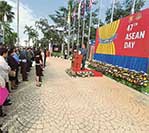2015 CHAIR: Malaysia must try to raise the profile of the grouping to be in line with its importance to the region
AS usual, Asean Day passed with barely a whimper on Aug 8. Small official receptions were held in member states’ capitals, flags were flown and the little-known Asean anthem sung. A few organisations chipped in with regional talks and seminars but nothing appeared even remotely eyebrow-raising. Asean may be the declared foreign policy cornerstones of member countries but, next to UFOs, appears to be the best kept secret from the public.
If nothing more, this presents Malaysia, Asean Chair in 2015, with something important to do: Try to raise the profile of what it means to be Asean more than a few notches so as to be in line with its importance to the region. Celebrations do not have to be as extravagant as those reserved for national days but they do need to be more visible (or less invisible) if the millions of dollars spent by governments each year are to have any traction on the ground.
Each passing generation of citizens since 1967 — or whatever year their country joined — is one more step away from the association’s raison d’etre. Before long, it will be nothing more than a hazy memory, if even that. With Japanese, Chinese and Korean soft power sweeping the region, (not that there is anything wrong with this), Asean already occupies smaller mind share among its youth. No prizes for guessing which countries the latter will think are critical for their welfare in the future.
Asean’s challenge is to continue engaging not just the current generation but future ones as well. This engagement has to go the beyond stage-managed, one-day-in-the-year cultural shows with national costumes, songs, dances and food. It is not enough to be content with the occasional and superficial; one has to strive for something that is more lived-in, rich and organic. The dangers of growing irrelevance for regional security and policy is at stake.
In 2007, a survey of over 2,170 Asean university students conducted for the Asean Foundation indicated that overall perceptions (albeit with interesting variations) indicated generally positive attitudes towards Asean. Drilling deeper, however, responses, while still positive, tended to be less affirmative or more ambivalent. There was familiarity and, with a few exceptions, strong comfort levels with at least the idea of Asean among its more elite youths.
For the public at large, however, a more recent effort in 2012, this time of Asean Community Building Efforts, showed that while there was 81 per cent name recognition among 2,228 respondents, 76 per cent did not know anything about it. This figure dropped to 30 per cent where businesses were concerned but only 55 per cent only had a basic understanding of what Asean was. This is insufficient for them to be anywhere near able to participate.
Going by website searches, interest in Asean, while rising, is still low. A check with a well-known search engine shows below 100 searches a month. Interestingly, the terms “Asean” together with “Community” attract more interest than just “Asean” alone.
According to one popular traffic estimation service, the Asean Secretariat’s website (www.asean.org) is also low, hardly averaging two page views per visitor and with daily time on site of less than four minutes.
The picture that emerges is that while Asean has broad surface-level appeal — primarily of the “wefeeling”, collegial and strength-in-numbers variety — the notion of Asean-ness as a facet of identity, let alone a thriving, interacting and interdependent community is still a long way off in the future. Asean is largely a conceptual, not concrete, construct and it is not anywhere close to being central in the public life of the region.
We need an Asean that is both information-rich and interaction-rich. In this technological age, there can be little excuse, except for apathy, for not trying to do more to connect the people of Asean in a much broader and more meaningful manner.
As governments and businesses play cynical games of hide-and-seek with economic, political and security policies for the Asean Community, there is no reason why people-to-people ties should be similarly inhibited.
The Internet permeates virtually every aspect of life, from cradle to grave, and is a growing force in Asean. There are already small bands of dedicated Aseanists exchanging news and views. The Asean Secretariat’s Twitter account has over 23,000 followers with many appearing to be region’s young individuals. (Of course, many outsiders and organisations also follow Asean’s goings-on.) Creating rich and vibrant virtual Asean communities can be a substantial step in incentivising innovation and creating the community that we want.
Article by Dato’ Steven Wong which appeared in New Straits Times,
26 August 2014.





